James Champlin Bucklin | |
|---|---|
| Born | 26 July 1801 |
| Died | September 1890 |
| Nationality | American |
| Occupation | Architect |

James C. Bucklin (1801-1890) was an American architect working in Providence, Rhode Island.
James Champlin Bucklin | |
|---|---|
| Born | 26 July 1801 |
| Died | September 1890 |
| Nationality | American |
| Occupation | Architect |

James C. Bucklin (1801-1890) was an American architect working in Providence, Rhode Island.
Bucklin was born on 26 July 1801, in a part of Rehoboth that is now part of Pawtucket, Rhode Island, to James and Lorania (Pearce) Bucklin. His father died 6 December 1802, and his widow moved to Providence with her son. Bucklin attended the town's public schools. At the age of 14 he was apprenticed to early architect-builder John Holden Greene, working there for seven years. In 1822, at the age of 21, he established a partnership with William Tallman (d.1862). The firm of Tallman & Bucklin was a design-build firm, similar to Greene's business. [1] in 1846, 20-year-old Thomas A. Tefft began working for Tallman & Bucklin. Before long, Tefft was doing most of the firm's design work. This continued until 1851, when Tefft finished his studies at Brown University and established his own office. [2] Also at this time, Tallman & Bucklin's partnership was dissolved. Bucklin worked alone for many years. By 1880 he had taken his son, James A. Bucklin (1840-1901), [3] as a partner in J. C. Bucklin & Son. Although son James largely took over the practice, he remained active until his death in September 1890. [1] The office was succeeded by J. A. Bucklin & Company. [4]
In 1829 Bucklin married Lucy Dailey of Providence. They had five surviving children, including son James. Lucy Bucklin died in November, 1888. [1]
Bucklin was a member of the Squantum Association and the Providence Athenaeum, and was considered "a great reader of good books". [1] He was a member of the Providence common council from the fifth ward for the years 1839-41 and 1842-43. [5] He was a member of the First Light Infantry.
Despite having fallen into relative obscurity, Bucklin was a very prominent designer in Providence from the 1840s to the 1870s. He designed at least half a dozen Westminster Street office buildings, as well as several more in other parts of downtown. From 1839 to 1844 Tallman & Bucklin had charge of the city's first major period of school-building, designing 12 buildings citywide. [6] Bucklin also was the designer of several other municipal structures.

For buildings built 1830-31, see Russell Warren.


For buildings built 1846-51, see Thomas A. Tefft.



Union Station describes two distinct, defunct train stations in Providence, Rhode Island. Parts of the latter one were renovated and the building contains offices and restaurants.

Thomas Alexander Tefft was an American architect, from Providence, Rhode Island. Tefft, one of the nation's first professionally trained architects, is considered a master of Rundbogenstil and a leading American proponent of its use. Prior to his untimely death, Tefft "offered the most advanced designs of [his] day in America"

The Westminster Arcade is a historic shopping center at 130 Westminster Street and 65 Weybosset Street in downtown Providence, Rhode Island built in 1828. It is notable as the first enclosed shopping mall in the United States and has been lauded as a fine example of commercial Greek Revival architecture. It served as a shopping center for many years before falling into decline in the late 20th century. It has since been closed for renovation and rehabilitation several times, and most recently reopened its doors in October 2013 as a residential and commercial mixed-use building. It was declared a National Historic Landmark in 1976.

The Beneficent Congregational Church is a United Church of Christ Congregationalist church located at 300 Weybosset Street in downtown Providence, Rhode Island. The congregation was founded in 1743 during the "First Great Awakening" as a separatist spin-off from a Congregationalist group on the east side of the Providence River, and built their first sanctuary on this site. The current church was built in 1809 and was extensively remodeled in the Greek Revival style in 1836.

Russell Warren (1783–1860) was an American architect, best known for his work in the Greek Revival style. He practiced in Bristol and Providence.

Stone, Carpenter & Willson was a Providence, Rhode Island based architectural firm in the late 19th and early 20th Centuries. It was named for the partners Alfred Stone (1834–1908), Charles E. Carpenter (1845–1923). and Edmund R. Willson (1856–1906). The firm was one of the state's most prominent.
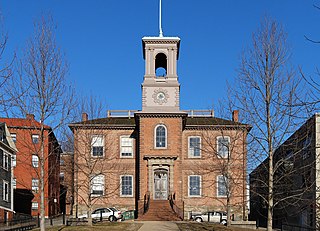
The Old State House on College Hill in Providence, Rhode Island, also known as Providence Sixth District Court House,Providence Colony House, Providence County House, and Rhode Island State House is located on 150 Benefit Street, with the front facade facing North Main Street. It is a brick Georgian-style building largely completed in 1762. It was used as the meeting place for the colonial and state legislatures for 149 years.
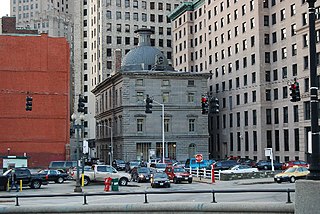
The Customhouse Historic District is a historic district encompassing fifteen historic buildings in downtown Providence, Rhode Island. The district is bounded by Westminster, Exchange, Dyer, Pine, and Peck Streets, and includes eight buildings associated with the important functions of the business center Providence became in the mid-to-late 19th century. It was listed on the National Register of Historic Places in 1975, and is completely contained within the Downtown Providence Historic District, listed in 1984.

The Market House is a historic three-story brick market house in Market Square, in the College Hill, a neighborhood of Providence, Rhode Island, USA. The building was constructed between 1773 and 1775 and designed by prominent local architects, Joseph Brown and Declaration of Independence signer Stephen Hopkins. The bottom floor of the house was used as a market, and the upper level was used for holding meetings. Similar buildings existed in other American cities, such as Faneuil Hall in Boston and the Old Brick Market in Newport. The building housed the Providence City Council in the decades before the completion of City Hall.
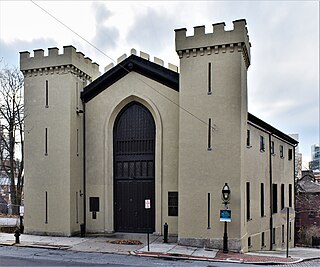
The State Arsenal, originally the Providence Marine Corps of Artillery Arsenal, and commonly called the Benefit Street Arsenal is a historic armory building located at 176 Benefit Street in the College Hill neighborhood of Providence, Rhode Island. It was built in 1829, was designed by Russell Warren in the Gothic Revival style, and was built by Tallman & Bucklin.

Clifton A. Hall (1826-1913) was an American architect from Providence, Rhode Island.

John Holden Greene (1777-1850) was a noted early nineteenth century architect practicing in Providence, Rhode Island. The bulk of his work dates to the late Federal period, and is mostly in the architectural style of the same name. Greene is responsible for the design of over fifty buildings built in the city between 1806 and 1830, almost half of which are still standing.

Alfred Stone was an American Architect. He was a founding partner of the Providence, Rhode Island, firm of Stone, Carpenter & Willson. Mr. Stone was best known for designing many prominent Rhode Island buildings, including the Providence Public Library, Union Station, buildings at Brown University and the University of Rhode Island, and many private homes.

William R. Walker & Son was an American architectural firm in Providence, Rhode Island, active during the years 1881 to 1936. It included partners William Russell Walker (1830–1905), William Howard Walker (1856–1922) and later William Russell Walker II (1884–1936).

Alpheus C. Morse (1818-1893) was an American architect with offices in Providence, Rhode Island.
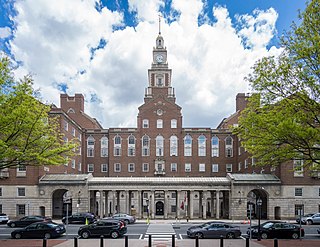
Jackson, Robertson & Adams was an architectural firm out of Providence, Rhode Island. Established in 1912, it was originally made up of architects F. Ellis Jackson (1879-1950), Wayland T. Robertson (1873-1935), and J. Howard Adams (1876-1924).
Howard Hoppin was an American architect from Providence, Rhode Island.

Charles P. Hartshorn was an American architect practicing in Providence, Rhode Island. He was a popular designer there in the decade immediately following the Civil War.

Dudley Newton (1845-1907) was an American architect from Newport, Rhode Island.
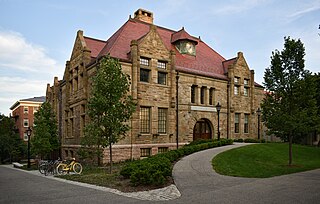
Thomas J. Gould (1849-1923) was an American architect from Providence, Rhode Island.